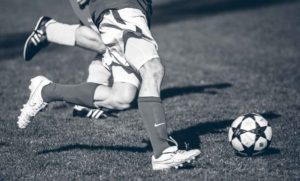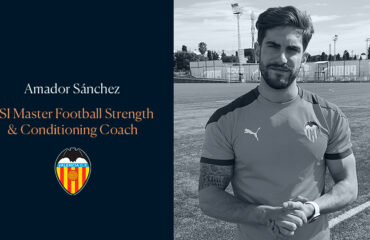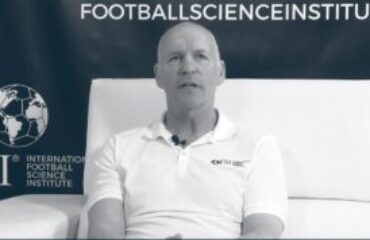1. Biomechanical Determinants of Performance and Injury Risk During Cutting: A Performance-Injury Conflict?
Dos’Santos T, Thomas C, McBurnie A, Comfort P, Jones PA.
Department of Sport and Exercise Sciences, Musculoskeletal Science and Sports Medicine Research Centre, Manchester Metropolitan University, All Saints Building, Manchester Campus John Dalton Building, Manchester Campus, Manchester, M15 6BH, UK. t.dossantos@mmu.ac.uk.
In this study of 61 males from multidirectional sports performing six 90° pre-planned cutting trials, kinetics and kinematics associated with faster cutting (i.e. faster center of mass velocities, greater final foot contact braking forces, short ground contact times, greater knee flexion moments, smaller hip and knee flexion, and greater internal foot progression angles) are in direct conflict with safer cutting mechanics (i.e. reduced knee joint loading, thus ACL injury risk). Practitioners should ensure that their athletes have the physical capacity (i.e. neuromuscular control, co-contraction, and rapid force production) to tolerate and support the knee joint loading during cutting.
Sports Med. 2021 Apr 3. doi: 10.1007/s40279-021-01448-3. Online ahead of print.
2. Multivariate Exploratory Comparative Analysis of LaLiga Teams: Principal Component Analysis.
Casal CA, Losada JL, Barreira D, Maneiro R.
Department of Science of Physical Activity and Sport, Catholic University of Valencia “San Vicente Mártir”, 46900 Valencia, Spain.
This study use principal component analysis (PCA) to study the matches corresponding to the 2015/16, 2016/17 and 2017/18 seasons of LaLiga. Goals, ball possession time in the final third of the field, number of effective shots and crosses are the main discriminating performance factors in these seasons.
Int J Environ Res Public Health. 2021 Mar 19;18(6):3176. doi: 10.3390/ijerph18063176.
3. A Meta-Analytical Comparison of the Effects of Small-Sided Games vs. Running-Based High-Intensity Interval Training on Soccer Players’ Repeated-Sprint Ability.
Clemente FM, Ramirez-Campillo R, Afonso J, Sarmento H, Rosemann T, Knechtle B.
Escola Superior Desporto e Lazer, Instituto Politécnico de Viana do Castelo Rua Escola Industrial e Comercial de Nun’Álvares, 4900-347 Viana do Castelo, Portugal.
This systematic review with a meta-analysis showed that neither small-sided games (SSGs)-based interventions nor running-based high-intensity interval training (HIIT) interventions were effective in improving soccer players’ repeated sprint ability (RSA), with no differences found between the effects of these two types of training, suggesting that complementary training or different forms of SSGs and HIITs may be performed to improve their effects.
Int J Environ Res Public Health. 2021 Mar 9;18(5):2781. doi: 10.3390/ijerph18052781.
4. The 360° Performance System in Team Sports: Is It Time to Design a “Personalized Jacket” for Team Sports Players?
Jukic I et al.
Faculty of Kinesiology, University of Zagreb, 10110 Zagreb, Croatia.
The best players in elite team sports have became incredibly skilled and physically powerful, which is a fact that potentiates the delivery of a product that is considered attractive, exciting, competitive, and very valuable from an economic and social standpoint. This scientific and applied study deals with the individual treatment of these players in order to improve their personal performance and, consequently, the team’s sporting performance.
Sports (Basel). 2021 Mar 17;9(3):40. doi: 10.3390/sports9030040.
5. Relationship between anterior cruciate ligament rupture and the posterior tibial and meniscal slopes in professional soccer athletes.
Ikawa MH, Yamada AF, da Rocha Corrêa Fernandes A, Skaf AY, Cohen M, Arliani GG.
Department of Radiology, Hospital do Coração (HCor) and Teleimagem, São Paulo, SP, Brazil.
This retrospective case-control study with knee magnetic resonance imaging revealed that posterior tibial and meniscal slopes were related to a greater risk of rupture of the ACL in professional male soccer players, and that the lateral and medial posterior meniscal slopes are predictors for ACL rupture.
Skeletal Radiol. 2021 Apr 7. doi: 10.1007/s00256-021-03776-x. Online ahead of print.
6. Quantification of Training Load Relative to Match Load of Youth National Team Soccer Players.
Szigeti G, Schuth G, Revisnyei P, Pasic A, Szilas A, Gabbett T, Pavlik G.
Department of Strength and Conditioning and Sport Science, Hungarian Football Federation, Budapest, Hungary.
This study in 84 youth U-17 national team players using GPS technology between 2016 and 2020, on the training load data relative to the match load obtained from 3 days before the actual match day (MD-3, MD-2, MD-1 days) revealed that the training volume was highest on MD-3 and lowest in MD-1, but high-intensity variables, such as maximum velocity, high-intensity accelerations, and meterage per minute were larger in the MD-1 training.
Sports Health. 2021 Apr 5:19417381211004902. doi: 10.1177/19417381211004902. Online ahead of print.
7. Vitamin D and Stress Fractures in Sport: Preventive and Therapeutic Measures-A Narrative Review.
Knechtle B, Jastrzębski Z, Hill L, Nikolaidis PT.
Medbase St. Gallen Am Vadianplatz, 9000 St. Gallen, Switzerland.
Among different risk factors, a prolonged lack of vitamin D (25(OH)D) can lead to stress fractures in athletes. This review concludes that in case of a deficiency of 25(OH)D, normal blood levels of ≥30 ng/mL may be restored by optimizing the athlete’s lifestyle and, if appropriate, an oral substitution of 25(OH)D daily with 800 IU 25(OH)D and 2000 mg calcium, whereas recommendations may go up to 2000 IU of 25(OH)D per day.
Medicina (Kaunas). 2021 Mar 1;57(3):223. doi: 10.3390/medicina57030223.





